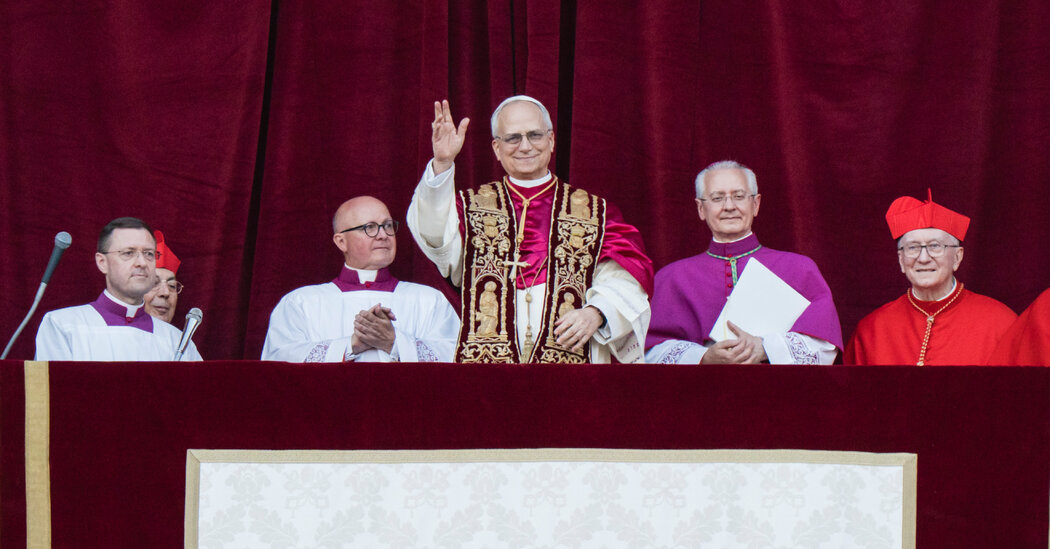An American was elected pope
Robert Prevost was elected yesterday as the new pope to lead the world’s 1.4 billion Catholics. He took the papal name Leo XIV and greeted a cheering crowd of followers at St. Peter’s Square by saying, “Peace be with you.”
The choice of an American to be pope was a break from tradition. “In a world that seems upside down, old taboos are also breaking in the Vatican, where the idea of an American pope was unimaginable for generations,” Jason Horowitz, our Rome bureau chief, said.
The cardinals reached their decision after a little more than 24 hours in the conclave. As pope, Leo will confront difficult decisions about the church’s direction, chiefly whether to continue Pope Francis’ agenda, championing greater inclusion and openness to change, or to chart a new course. We have reactions and live updates here.
Who is Leo? Born in Chicago, the 69-year-old pontiff spent much of his life outside the U.S. He served as missionary, parish priest, teacher and bishop for two decades in Peru. He was made a cardinal by Francis less than two years ago. Until the death of Francis, he held one of the most influential Vatican posts, running the office that selects and manages bishops globally.
A member of the Order of St. Augustine, he resembles Francis in his commitment to the poor and migrants and to meeting people where they are. It is unclear whether he will be as open to gay, lesbian, bisexual and transgender Catholics as Francis was. Here’s what else we know about him.
What’s next: Leo will celebrate Mass at the Sistine Chapel today with the cardinals who elected him. He will recite a prayer on Sunday at St. Peter’s Basilica. And, on Monday, he will meet with journalists at the Vatican.
In photos: See the moment Leo emerged as pope.
Trump’s trade deal with Britain left details to be settled
President Trump said Britain had agreed yesterday to a new trade deal that would increase market access for billions of dollars of U.S. exports. It was the first agreement that the Trump administration has reached since imposing higher tariffs on its trading partners.
Both sides will need to meet in the coming months, with many details left to be worked out. The 10 percent tariff that Trump imposed in April on Britain and other nations will remain in place, but tariffs will be pared back on British steel, aluminum and automobiles. In return, Britain will open up access to beef, ethanol, and other U.S. products.
Context: Whatever the final deal ends up being, it may be more important to Britain than to the U.S. Britain occupies the No. 11 spot among major trading partners of the U.S., while the U.S. is Britain’s largest partner.
Who’s next?: E.U. officials drew up a list of 95 billion euros worth of U.S. goods that they could target with higher tariffs. Hours later, Trump said U.S. officials “intend to make a deal” with Europe. A first round of U.S.-China trade talks is expected to take place this weekend in Switzerland.
Related: Toyota predicted a $1.3 billion hit from tariffs in April and May alone.
Danger grows in South Asia
Both India and Pakistan yesterday said that their military sites had come under attack, and heavy shelling and strikes were reported overnight on each side of their border. Secretary of State Marco Rubio spoke with leaders from both countries and emphasized the need for “immediate de-escalation,” the State Department said.
“Why am I cutting lettuce like a steak?” one diner asked.
CONVERSATION STARTERS
The museum of the century
Tate Modern in London, which turns 25 this week, made its greatest impact by re-envisioning itself as a theme park as well as a museum. It offered not just art to marvel at, but also experiences to be felt, our critic Jason Farago writes. It quickly became a hit.
But now, the glory has faded. Visitor numbers are down 20 percent since before the pandemic, and funding crises have led to multiple rounds of layoffs. Is there a pathway back?











